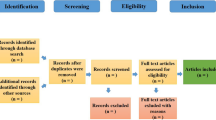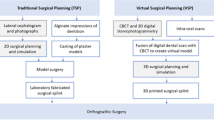Abstract
Purpose
To determine if the method of orthognathic surgery planning used—computer aided surgical simulation (CASS) versus analog model surgery—influenced patients’ post-operative satisfaction. The authors hypothesized that there was no difference in patient satisfaction based on the type of planning in orthognathic surgery.
Methods
This was a single-site, observational, retrospective cohort study consisting of a standardized survey aimed to be given to all patients who had orthognathic surgery at the authors’ institution over a 6-year period. Patients were asked to complete a survey questionnaire that consisted of eight questions, each utilizing a five-point Likert scale.
Results
There were 643 patients initially identified with 401 potential subjects meeting the inclusion criteria. Of these 401 patients, the survey was successfully administered to 161. Patients whose orthognathic surgery was planned virtually were not only significantly more likely to be satisfied with their appearance post-operatively, but also more likely to go through with surgery again if they could choose to (p < 0.05). CASS patients were also more likely to identify that their surgery was planned virtually. When stratified by age, younger patients were more likely to have read about CASS. When each survey question was stratified based on the type of surgery that was performed, there were no significant differences.
Conclusion
Patients whose surgeries were virtually planes were significantly more likely than model surgery patients to be satisfied with their post-operative appearance as well as with their decision to have orthognathic surgery. CASS has proven to be an accurate, time-saving, and potentially cost-saving tool for surgeons. Based on the results of this study, the type of surgical planning method matters for post-operative patient satisfaction with their appearance.





Similar content being viewed by others
References
Hullihen SP (1849) Case of elongation of the under jaw and distortion of the face and neck, caused by a burn, successfully treated. Am J Dent Sci 9:157–165
Whipple J (1898) Double resection of the inferior maxilla for protruding lower jaw. Dent Cosm 40:552–557
Steinhäuser EW (1996) Historical development of orthognathic surgery. J Cranio-Maxillofac Surg 24:195–204. https://doi.org/10.1016/S1010-5182(96)80002-3
Bell RB (2018) A history of orthognathic surgery in North America. J Oral Maxillofac Surg 76:2466–2481. https://doi.org/10.1016/j.joms.2018.09.006
Trauner R, Obwegeser H (1957) The surgical correction of mandibular prognathism and retrognathia with consideration of genioplasty. I. Surgical procedures to correct mandibular prognathism and reshaping of the chin. Oral Surg Oral Med Oral Pathol 10:677–689; contd. https://doi.org/10.1016/s0030-4220(57)80063-2
Kole H (1959) Surgical operations on the alveolar ridge to correct occlusal abnormalities. Oral Surg Oral Med Oral Pathol 12:515–529 concl. https://doi.org/10.1016/0030-4220(59)90153-7
Obwegeser HL (1969) Surgical correction of small or retrodisplaced maxillae. The “dish-face” deformity. Plast Reconstr Surg 43:351–365. https://doi.org/10.1097/00006534-196904000-00003
Bell WH (1973) Biologic basis for maxillary osteotomies. Am J Phys Anthropol 38:279–289. https://doi.org/10.1002/ajpa.1330380223
Epker BN (1984) Vascular considerations in orthognathic surgery. II. Maxillary osteotomies. Oral Surg Oral Med Oral Pathol 57:473–478. https://doi.org/10.1016/0030-4220(84)90302-5
Ellis E (1990) Accuracy of model surgery: evaluation of an old technique and introduction of a new one. J Oral Maxillofac Surg Off J Am Assoc Oral Maxillofac Surg 48:1161–1167. https://doi.org/10.1016/0278-2391(90)90532-7
Ellis E, Tharanon W, Gambrell K (1992) Accuracy of face-bow transfer: effect on surgical prediction and postsurgical result. J Oral Maxillofac Surg Off J Am Assoc Oral Maxillofac Surg 50:562–567. https://doi.org/10.1016/0278-2391(92)90434-2
Anwar M, Harris M (1990) Model surgery for orthognathic planning. Br J Oral Maxillofac Surg 28:393–397. https://doi.org/10.1016/0266-4356(90)90037-l
Sharifi A, Jones R, Ayoub A et al (2008) How accurate is model planning for orthognathic surgery? Int J Oral Maxillofac Surg 37:1089–1093. https://doi.org/10.1016/j.ijom.2008.06.011
Bell RB (2011) Computer planning and intraoperative navigation in orthognathic surgery. J Oral Maxillofac Surg Off J Am Assoc Oral Maxillofac Surg 69:592–605. https://doi.org/10.1016/j.joms.2009.06.030
Stokbro K, Aagaard E, Torkov P et al (2014) Virtual planning in orthognathic surgery. Int J Oral Maxillofac Surg 43:957–965. https://doi.org/10.1016/j.ijom.2014.03.011
Farrell BB, Franco PB, Tucker MR (2014) Virtual surgical planning in orthognathic surgery. Oral Maxillofac Surg Clin N Am 26:459–473. https://doi.org/10.1016/j.coms.2014.08.011
Bengtsson M, Wall G, Larsson P et al (2018) Treatment outcomes and patient-reported quality of life after orthognathic surgery with computer-assisted 2- or 3-dimensional planning: a randomized double-blind active-controlled clinical trial. Am J Orthod Dentofac Orthop Off Publ Am Assoc Orthod Its Const Soc Am Board Orthod 153:786–796. https://doi.org/10.1016/j.ajodo.2017.12.008
Posnick JC, Wallace J (2008) Complex orthognathic surgery: assessment of patient satisfaction. J Oral Maxillofac Surg Off J Am Assoc Oral Maxillofac Surg 66:934–942. https://doi.org/10.1016/j.joms.2008.01.014
Sinclair M, O’Toole J, Malawaraarachchi M, Leder K (2012) Comparison of response rates and cost-effectiveness for a community-based survey: postal, internet and telephone modes with generic or personalised recruitment approaches. BMC Med Res Methodol 12:132. https://doi.org/10.1186/1471-2288-12-132
McCormick SU, Drew SJ (2011) Virtual model surgery for efficient planning and surgical performance. J Oral Maxillofac Surg Off J Am Assoc Oral Maxillofac Surg 69:638–644. https://doi.org/10.1016/j.joms.2010.10.047
Schwartz HC (2014) Does computer-aided surgical simulation improve efficiency in bimaxillary orthognathic surgery? Int J Oral Maxillofac Surg 43:572–576. https://doi.org/10.1016/j.ijom.2013.10.018
Xia JJ, Gateno J, Teichgraeber JF et al (2007) Accuracy of the computer-aided surgical simulation (CASS) system in the treatment of patients with complex craniomaxillofacial deformity: a pilot study. J Oral Maxillofac Surg Off J Am Assoc Oral Maxillofac Surg 65:248–254. https://doi.org/10.1016/j.joms.2006.10.005
Xia JJ, Shevchenko L, Gateno J et al (2011) Outcome study of computer-aided surgical simulation in the treatment of patients with craniomaxillofacial deformities. J Oral Maxillofac Surg 69:2014–2024. https://doi.org/10.1016/j.joms.2011.02.018
Xia JJ, Phillips CV, Gateno J et al (2006) Cost-effectiveness analysis for computer-aided surgical simulation in complex cranio-maxillofacial surgery. J Oral Maxillofac Surg Off J Am Assoc Oral Maxillofac Surg 64:1780–1784. https://doi.org/10.1016/j.joms.2005.12.072
Gateno J, Xia J, Teichgraeber JF et al (2003) The precision of computer-generated surgical splints. J Oral Maxillofac Surg Off J Am Assoc Oral Maxillofac Surg 61:814–817. https://doi.org/10.1016/s0278-2391(03)00240-4
Hsu SS-P, Gateno J, Bell RB et al (2013) Accuracy of a computer-aided surgical simulation protocol for orthognathic surgery: a prospective multicenter study. J Oral Maxillofac Surg 71:128–142. https://doi.org/10.1016/j.joms.2012.03.027
Ritto FG, Schmitt ARM, Pimentel T et al (2018) Comparison of the accuracy of maxillary position between conventional model surgery and virtual surgical planning. Int J Oral Maxillofac Surg 47:160–166. https://doi.org/10.1016/j.ijom.2017.08.012
Author information
Authors and Affiliations
Corresponding author
Ethics declarations
Ethical approval
This study was performed in line with the Declaration of Helsinki and approved by the Institutional Review Board at the University of Texas, Southwestern Medical Center.
Consent to participate
Each patient gave express consent to be included as a participant in this project and for results to be published.
Consent for publication
All the authors agreed to the terms and conditions associated with applying for publication to Oral and Maxillofacial Surgery and contributed to the writing of this manuscript.
Conflict of interests
The authors declare no competing interests.
Additional information
Publisher's note
Springer Nature remains neutral with regard to jurisdictional claims in published maps and institutional affiliations.
Rights and permissions
Springer Nature or its licensor holds exclusive rights to this article under a publishing agreement with the author(s) or other rightsholder(s); author self-archiving of the accepted manuscript version of this article is solely governed by the terms of such publishing agreement and applicable law.
About this article
Cite this article
Bueno, S., Hammad, Y. & Schlieve, T. Does the type of planning in orthognathic surgery influence patient satisfaction?. Oral Maxillofac Surg 27, 685–692 (2023). https://doi.org/10.1007/s10006-022-01114-6
Received:
Accepted:
Published:
Issue Date:
DOI: https://doi.org/10.1007/s10006-022-01114-6




